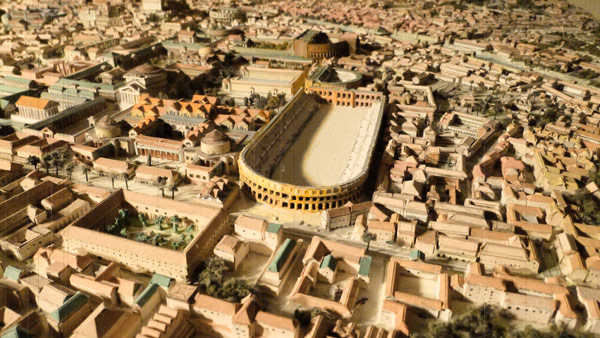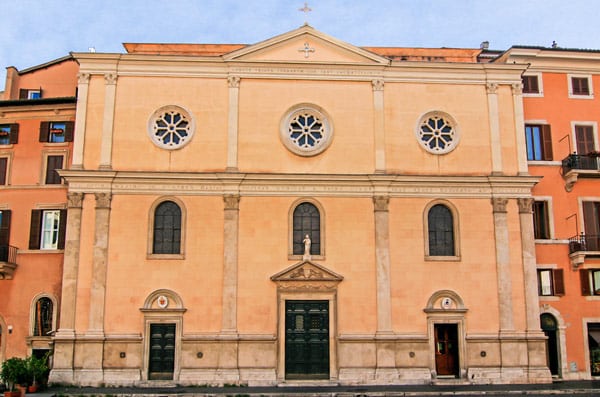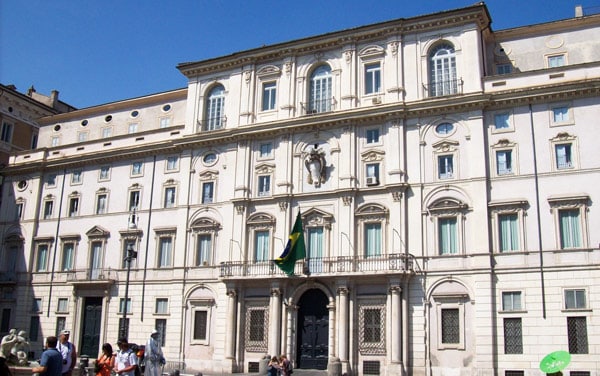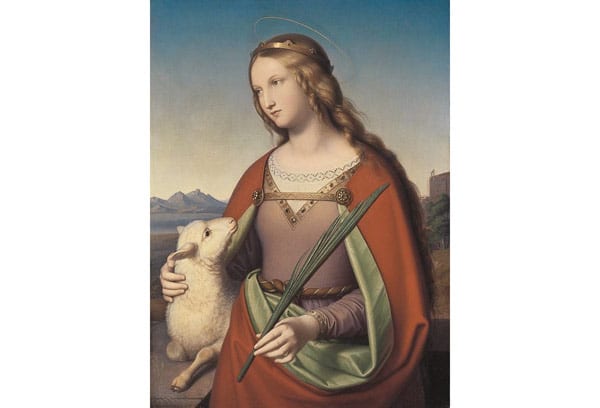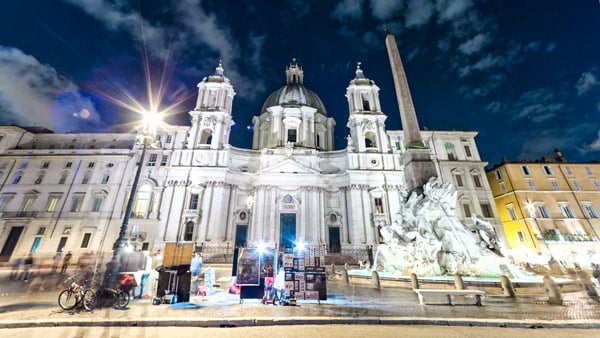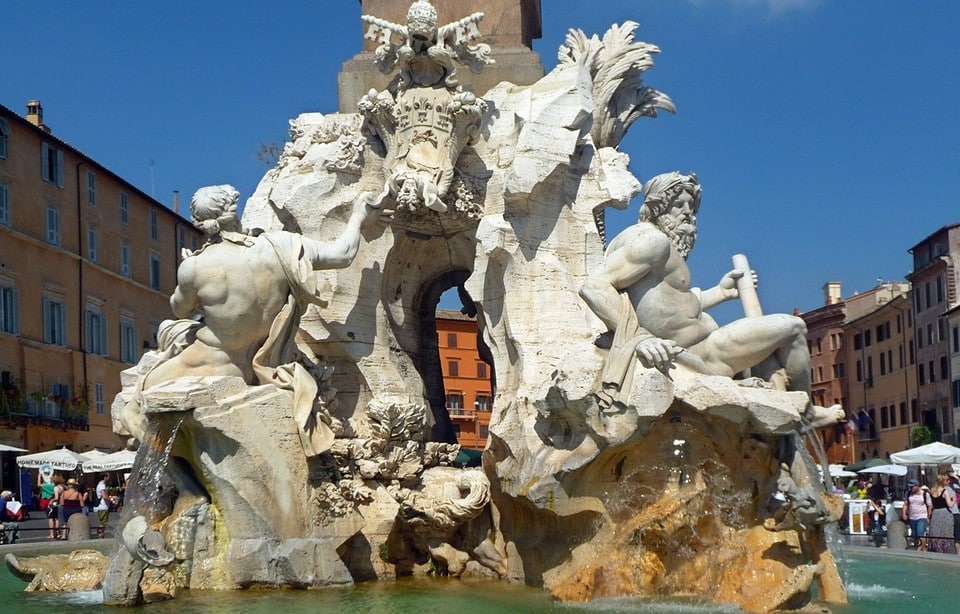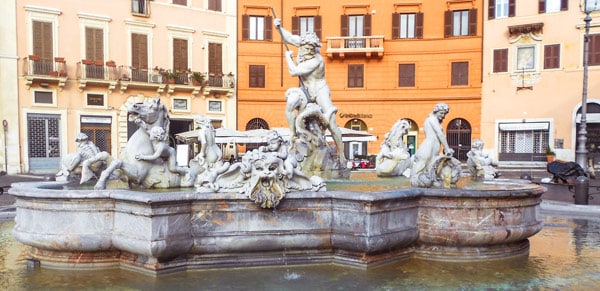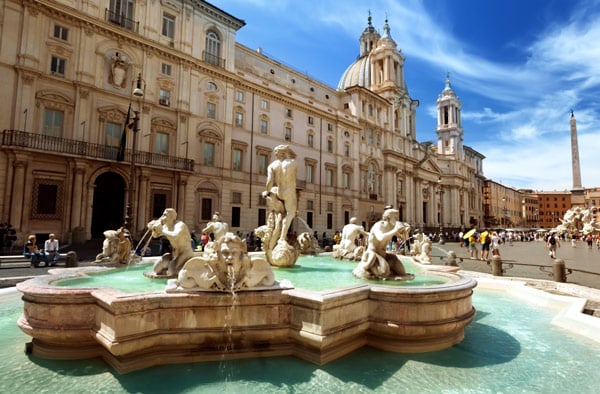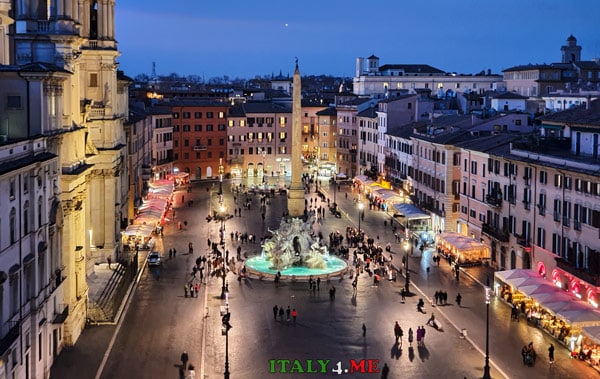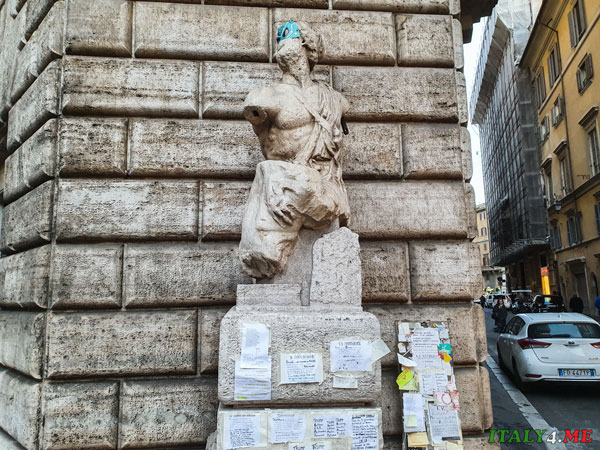Piazza Navona is, without a doubt, the most elegant and sunny spot in Rome. In ancient times, this piece of land served as a stadium for athletic competitions. But modern visitors to Rome can feast their eyes on luxurious Baroque fountains and explore medieval temples.
Page Contents
History
In 80 AD, the Domitian Stadium (Stadio di Domiziano) was built in Rome. This structure was a gift from Emperor Titus Flavius Domitianus to the city’s inhabitants and was mainly used for sporting events.
The stadium also had another name – Arena of Agones (from ancient Greek “ἀγών” – “competition”). It was this term that gave Piazza Navona its name. In the early centuries of our era, the stadium was called “campus agonis,” and as the Middle Ages approached, this term transformed into “n’agone.” Eventually, the name simplified to “navona.”
The ancient stadium was quite impressive, measuring 275 by 106 meters, with seating for 15,000 spectators! The building was richly adorned both inside and out. The arcades surrounding the stadium housed stalls and entertainment establishments. Notably, one of the public houses near the stadium eventually transformed into a church.
Early Christian Period
Santa Maria del Sacro Cuore Church
On the north side of Piazza Navona stands the Santa Maria del Sacro Cuore Church (Nostra Signora del Sacro Cuore). The church, dedicated to the Virgin Mary, was erected on the ruins of the Domitian Stadium in the 12th century. King Ferdinand III of Castile (Ferdinand III) bequeathed the money for the construction of the temple. From the 16th to the 17th century, the basilica held the status of the Spanish national church in Rome.
In the 19th century, thanks to the efforts of Pope Leo XIII, the Santa Maria del Sacro Cuore Church was restored. The entrance to the building was moved from the internal streets of the capital to Piazza Navona. The church’s altar decoration and many paintings inside the temple were created by the Renaissance painter Francisco de Castello.
The Baroque Era
Piazza Navona is the most outstanding example of the Baroque style (barocco) that can be found in Rome. The Baroque era came to this corner of the capital thanks to the Pamphilj family. In the late 15th century, a member of this family acquired three ancient houses standing on the square. A century and a half later, Giambattista Pamphili became the Roman Pope and took the name Innocent X.
The pope decided to build a family palace in the southern part of Piazza Navona. To achieve this, he hired the Baroque architect Girolamo Rainaldi. Thanks to this master, Palazzo Pamphilj acquired its elegant facade. The interior of the palace was handled by Francesco Borromini. The pope presented this magnificent Roman mansion to his relative Olimpia Maidalchini.
Palazzo Pamphilj boasts 23 halls and a beautiful gallery that runs through the entire first floor of the mansion. The vaults of the gallery were decorated with frescoes by Pietro da Cortona in 1651. In 1672, the Church of St. Agnes was added to the palace, where Pope Innocent X was buried. Nowadays, the building houses the Brazilian Embassy.
Legend about Agnes of Rome
There is an intriguing story about a Roman girl named Agnes (Latin: Agnessa).
In the 3rd century AD, the beautiful maiden lived in Rome. She embraced the Christian faith and was prepared to devote herself entirely to the church. Unfortunately, the Roman prefect fell in love with her and would not accept rejection. Angry at pious Agnes, the official ordered her to be stripped and sent in that state to a brothel near the Domitian Stadium.
However, her protectors did not abandon her in her hour of need. Her flowing hair helped shield her from the leering eyes of the crowd. Angels brought a white garment, which the faithful Christian donned. She was protected by her faith In the brothel, and all Romans left the captive’s room in shame. In January 304, the unyielding Roman woman embraced martyrdom at the hands of soldiers.
On the very spot where the ancient brothel stood, a church was built in honor of Agnes of Rome in the mid-17th century. Sant’Agnese in Agone is an elegant white basilica executed in the Baroque style.
The church faces Piazza Navona, inviting travelers to check it out inside. Saint Agnes’ head is kept in the church as a revered relic.
Fountains
Piazza Navona in Rome is adorned with three Baroque fountains.
Fountain of the Four Rivers
In the center of the square stands the Fountain of the Four Rivers (Fontana dei Quattro Fiumi), splashing with waters from an ancient Roman aqueduct. It was built by Giovanni Lorenzo Bernini in 1648-51.
Originally, the center of the square featured an imitation of an ancient Egyptian obelisk. This was an attempt by the Pamphilj family to give more importance to their possessions. However, the talented architect found a way to ingeniously integrate the 16-meter stone column. The elegant Baroque fountain was adorned with statues of river deities representing the Nile, Danube, Ganges, and La Plata.
Bernini vs. Borromini
The real highlight of the square is the skillfully adorned church of Saint Agnes, decorated in exquisite Baroque style. The basilica was designed by Francesco Borromini. Opposite the church’s facade stands the most impressive of the three fountains – the Fountain of the Four Rivers. At one point, Borromini and Bernini worked together until their rivalry for influential clients ruined their collaboration.
Among Roman guides, there’s a popular legend that these rivals managed to express their animosity through the decoration of the city’s landmarks. The sculptures of men representing four rivers supposedly pointedly turn away from the church’s facade. And the statue of Saint Agnes disapprovingly gazes down from her height at the famous fountain’s sculptural group.
Neptune Fountain
On the north side of Piazza Navona stands the Neptune Fountain (Fontana del Nettuno), built by Giacomo della Porta in 1574. Initially, the fountain was modest and lacked any ornamentation. Only at the end of the 19th century did it receive decorative elements. The powerful figure of the sea god wielding his trident against an octopus added character to the city’s water feature. The sculptural group of the Neptune Fountain is the work of architect Antonio della Bitta.
Moor Fountain
In the southern part of the square, you’ll find the Moor Fountain (Fontana del Moro), which emerged in 1576 based on the design by architect Giacomo della Porta. Originally, the waters of the fountain featured four stone tritons. However, in 1654, Bernini transformed the Moor Fountain on the request of Olympia Maidalchini. The fountain gained a more glamorous appearance with a central figure of a Moor competing with a dolphin.
At the request of Olympia Maidalchini, the fountain gained more of a glamorous touch. In the center of the fountain, a figure of a Moor competing with a dolphin emerged.
Braschi Palace
Braschi Palace (Palazzo Braschi) was established in Rome in 1792. A close relative of Pope Pius VI decided to have a family palace overlooking Piazza Navona.
Cosimo Morelli developed the architectural design and became the overseer of the mansion’s construction. However, Napoleon’s invasion froze the finishing touches until 1811. The Braschi family lost their rights to the palace, and the Italian government struggled to find a purpose for the luxurious building.
Starting from 1949, Palazzo Braschi was used as a shelter for 300 Italian families. In 1952, the palace became the Museum of Rome. Interestingly, one of the ancient Roman “talking” statues, known as Pasquino, stands near the building, dating back to the 2nd century BC.
The statue called Pasquino used to represent the feelings of ordinary Romans towards the official authorities. In the Middle Ages, the base of the statue turned into an anonymous board for posting anonymous complaints and criticisms.
Today, the museum is open from Tuesday to Sunday, from 9:00 a.m. to 7:00 p.m., with a ticket cost of 9 EUR. Official web site: www.museodiroma.it/sede/palazzo_braschi
Modern Life of the Square
Since ancient times, the Domitian Stadium hosted fairs and various tournaments. In the Middle Ages, Piazza Navona became the venue for religious processions and celebrations. From the 15th century for four centuries, the square became the location for weekly markets.
Currently, once a year, Piazza Navona hosts the Christmas market called “Befana di piazza Navona.” Otherwise, this corner of the city is beloved by tourists who want to admire the Baroque fountains and the massive obelisk. Souvenir shops along the square help visitors keep memories of Rome and its beauty.
How to Get to Piazza Navona
Getting to Piazza Navona is easy as it is surrounded by major Roman landmarks.
- From Castel Sant’Angelo: Walk along the riverside towards the Palace of Justice, cross the Tiber River over Umberto I Bridge, continue along Via Giuseppe Zanardelli, and you’ll arrive at the northern part of the square near the Moor Fountain. Travel time: 15 minutes.
- From the Pantheon: In fact, it’s just a 500-meter walk from the Pantheon to Navona. Your task is to choose the right direction, following the signs.
 Italy for me From Italy with love
Italy for me From Italy with love


